![]()
![]()
![]()
(Full index of popular Covert Shores articles)
UPDATED Originally posted Jan 24.
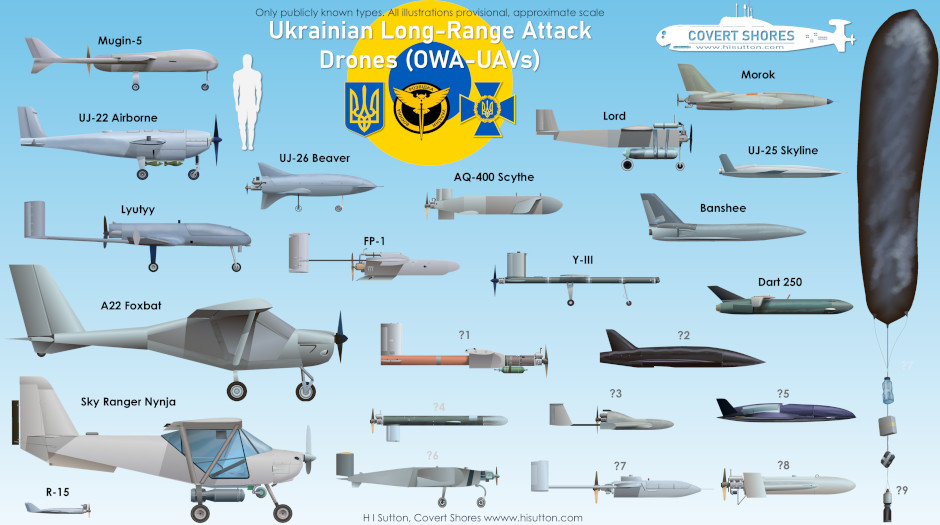
CLICK to Enlarge.
Guide To Ukraine's Long Range Attack Drones
 Russia’s use of long range drones, principally the Iranian Shahed type, against Ukraine is well documented. These are termed one-way attack drones (OWA-UAVs), or informally as 'Kamikaze drones'. These are used as part of large scale attacks combined with more expensive cruise missiles. While the Shaheds are valid offensive weapons in their own right, they are being used to stretch Ukrainian air defenses and create better chances for the larger cruise missiles.
Russia’s use of long range drones, principally the Iranian Shahed type, against Ukraine is well documented. These are termed one-way attack drones (OWA-UAVs), or informally as 'Kamikaze drones'. These are used as part of large scale attacks combined with more expensive cruise missiles. While the Shaheds are valid offensive weapons in their own right, they are being used to stretch Ukrainian air defenses and create better chances for the larger cruise missiles.
Ukraine too is increasingly using this type of drone. Like Russia, Ukraine can use OWA-UAVs as part of larger packages to improve the success of cruise missiles.But Ukraine also uses them for very long ranged attacks on strategic targets deep inside Russia. This has several purposes. The targets themselves, such as oil storage sites and airfields, are of strategic importance. These attacks also serve to make the Russian population more aware of the war. And, it stretches Russian air defenses forcing some to be deployed far away from the front lines.
This article will focus on the Ukrainian OWA-UAVs which can strike deep into Russia. It relies on public information; the usual caveats apply.
Mugin-5
Initially Ukraine leveraged commercially available drones such as the Chinese built Mugin-5 (aka Skyeye 5000). These were employed in August 2022 to attack the Black Sea Fleet headquarters in Sevastopol, Crimea. Other examples struck critical infrastructure. These have been superseded by Ukrainian produced designs.
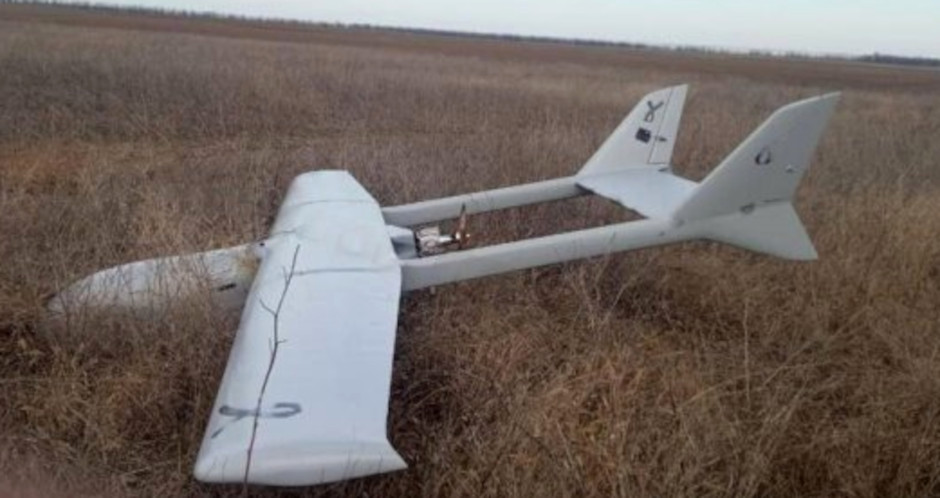
Mugin-5 crashed in Crimea, February 2023
UJ-22 Airborne
The Ukrjet UJ-22 Airborne is a single engine drone which can either carry an internal warhead or several air-dropped bombs. Payload is up to 20 kg. It has a traditional light aircraft layout with tractor propeller (i.e. at the front) and simple straight wings and fixed undercarriage. At about 3.7 meters (12 ft) long and a wingspan of 4.2 meters (14 ft) it is one of the largest OWA-UAVs known to be in service. Range is reported as 800 km (500 miles).
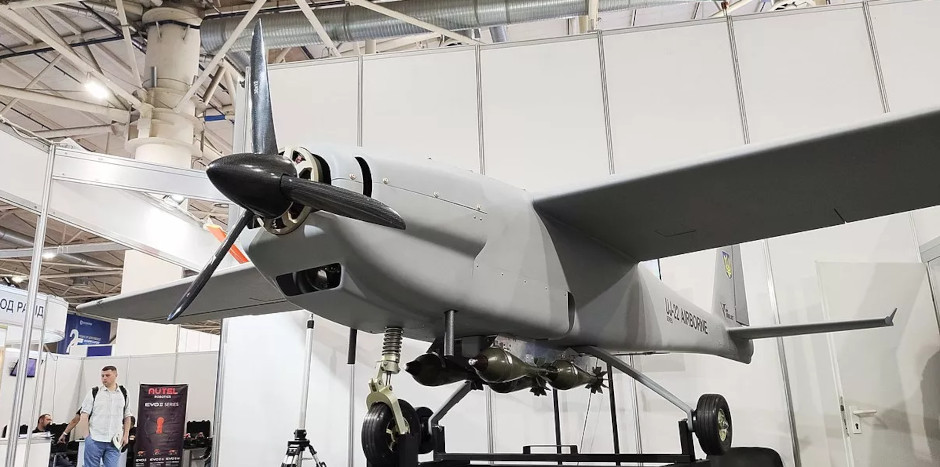
UJ-22 Airborne
The UJ-22 is confirmed to have been employed in attacks on Moscow including in February 2023.
Morok
A sleek-looking OWA-UAV based on the RZ-60 target drone. It has a comparatively shorter range of 300 km and a small warhead of just 3 kg (although there are Russian reports of 20kg warheads). It is launched with the aid of a rocket and can achieve a respectable 290 kmph.
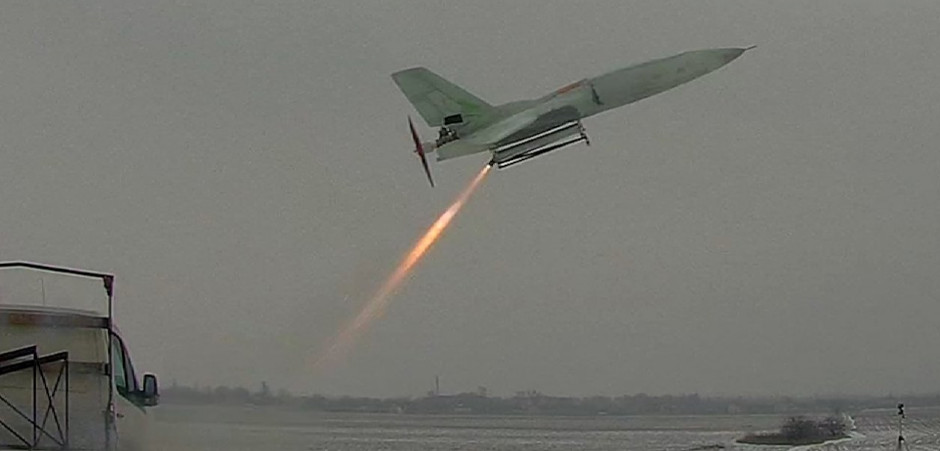
Morok
UJ-25 Skyline
The UJ-25 Skyline is essentially a weaponized development of the Ukrajet UJ-23 Topaz target drone. It is a jet powered type with generally stealthy lines and distinctive forward swept wings. Few details are available. At least one has been reported in Russia.
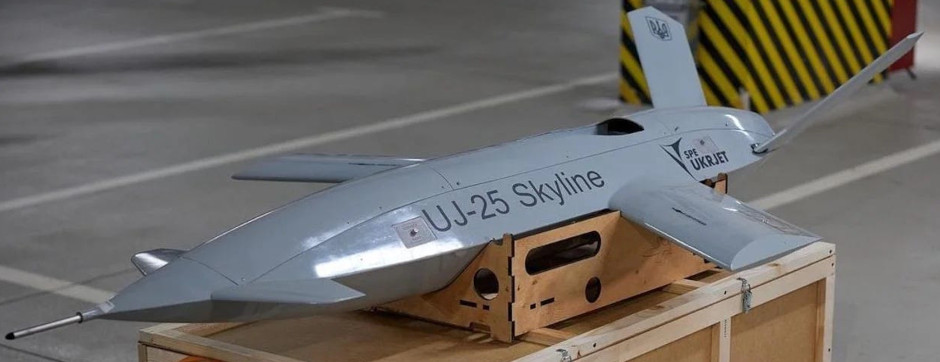
UJ-25 Skyline
UJ-26 Beaver
One of the better known types, the Beaver (Bober) has a distinctive canard layout with sleek fuselage and inverted tail. The type was introduced in 2023 and has reportedly entered mass production. Range is in the order of 1,000 km (620 miles) and payload is reported as 20 kg (44 lb). This type has been used to attack Moscow and other targets in Russia.
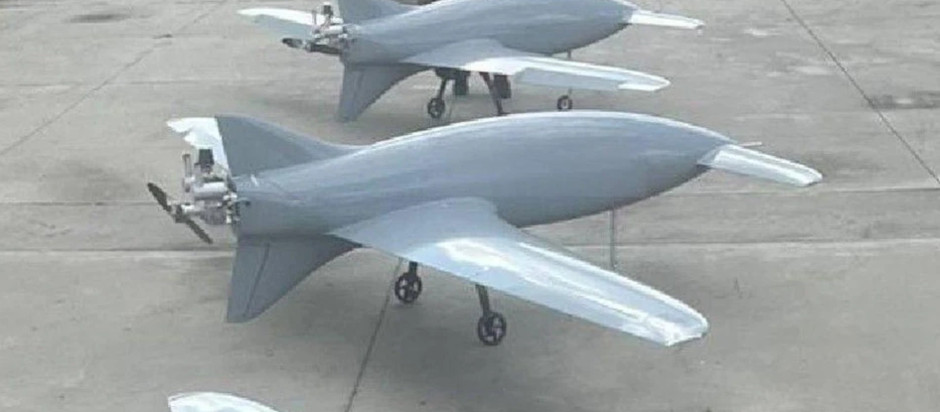
UJ-26 Beaver
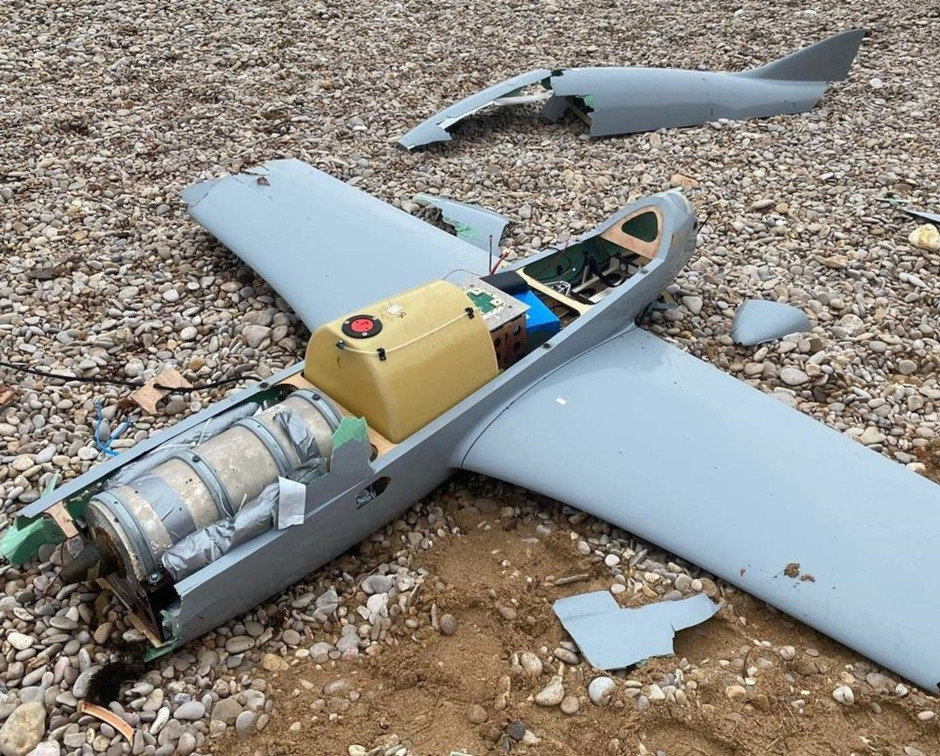
Crashed UJ-26 Beaver in Crimea showing the warhead and fuel tank arrangement.
An-196 Lyutyy / Fierce
The Antanov An-196 Lyutyy is relatively large with a traditional UAV construction. It has a passing resemblance to the Turkish-made Bayraktar TB2 but not in detail. The design was revealed by Anna Gvozdyar, Deputy Minister for Strategic Industries in November 2022 and has since been onfirmed to be an Antonov / Ukroboronprom design.
It is apparent from photographic evidence that Lyutyy is related to the pre-war Antonov AN-BK-1 Horlytsia (Turtle Dove) design.Antonov was previously reported to be developing a heavy strike UAV, and has widely been reported to have switched to drone production after the 2022 invasion.
The Lyutyy has light aircraft-like construction suggesting a higher unit cost, but appears to have a comparatively longer range and greater payload than some other designs.
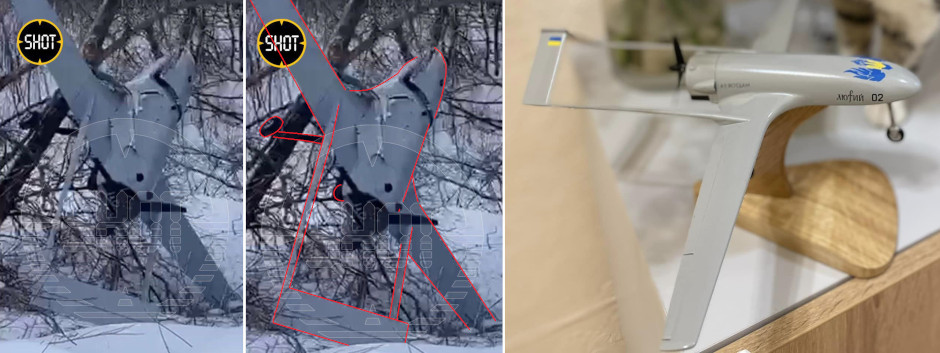
Lyutyy crashed in Nizhny Novgorod, Jan 31 2024, and reference model.
AQ-400 Scythe
The Terminal Autonomy AQ-400 Scythe is a volunteer project which has entered serial production. It has a crude box-like fuselage and tandem wings with distinct end plates on the forward set. Range is slightly shorter than some other types, reported at 750 km (465 miles) but payload heavier at 32 kg (70 lb). Payload can reportedly be increased to some 70 kg (154 lb) with a reduced range.
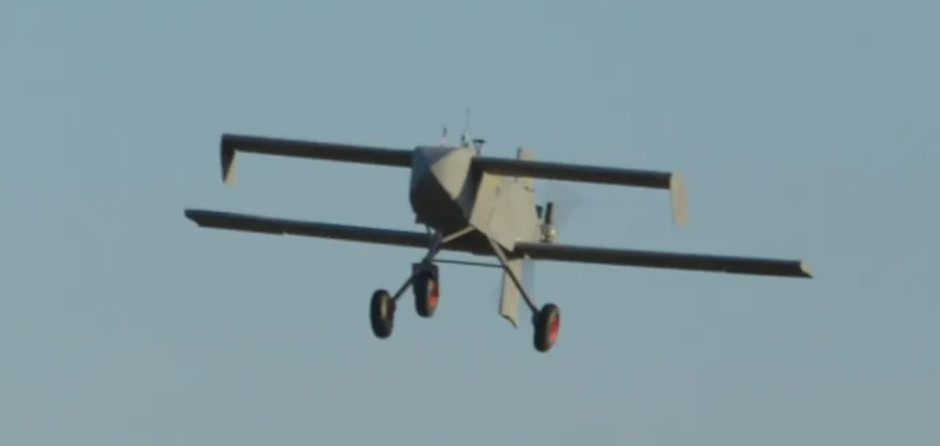
AQ-400 Scythe. Note that the undercarriage can be replaced by a dolly or launch rail arrangement.
Lord
 /
/  Developed by Swiss headquartered aerospace company Destinus, the Lord is a relatively straightforward design. Its aerodynamic simplicity, box-like fuselage and modest size all point to low cost construction. Certainly it appears, like the AQ-400 Scythe and some others, to be emphasizing producibility. Performance is likely respectable, possibly in the region of 750 km with a relatively large payload.
Developed by Swiss headquartered aerospace company Destinus, the Lord is a relatively straightforward design. Its aerodynamic simplicity, box-like fuselage and modest size all point to low cost construction. Certainly it appears, like the AQ-400 Scythe and some others, to be emphasizing producibility. Performance is likely respectable, possibly in the region of 750 km with a relatively large payload.

Y-III
 A Turkish-Pakistani project, the Y-III has a long and thin fuselage with unswept wings and uniform tail surfaces. Production is missile-like and relatively complex. Given its small internal volume, range may be shorter than some other designs, but it has been used against targets inside Russia. Separately, the type has also been employed by Pakistan to strike targets in Iran.
A Turkish-Pakistani project, the Y-III has a long and thin fuselage with unswept wings and uniform tail surfaces. Production is missile-like and relatively complex. Given its small internal volume, range may be shorter than some other designs, but it has been used against targets inside Russia. Separately, the type has also been employed by Pakistan to strike targets in Iran.

Reference photo of Y-III on display in Pakistan.
Banshee
 At least one British-made Banshee target drone has been reported crashed behind Russian lines. The Banshee is a high-performamnce twin jet drone used by the Royal Navy. Further details of weaponization unclear.
At least one British-made Banshee target drone has been reported crashed behind Russian lines. The Banshee is a high-performamnce twin jet drone used by the Royal Navy. Further details of weaponization unclear.
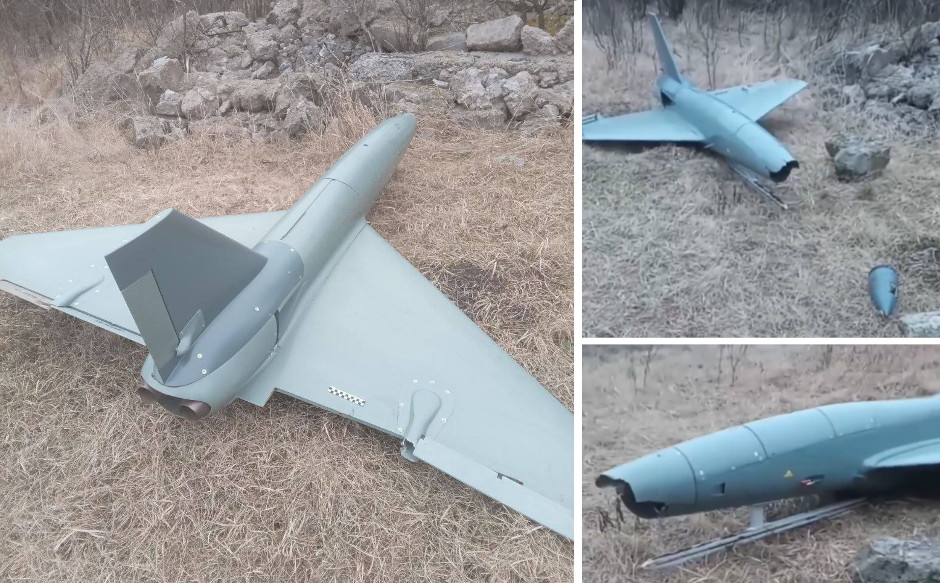
R-15
An unswept-flying wing design with single propeller in tractor (front mounted) configuration and twin tails. This is smaller than most of the other 'long range' drones being only 1.2 meters long, with a wingspan of around 2.4 meters. The type is associated with Ukrainian philanthropist and volunteer Serhiy Prytula. In May 2023 the type was apparently used in an attack on the Ilsky refinery in Krasnodar Krai. Then in March 2024 it appeared again during large-scale attacks involving multiple types.
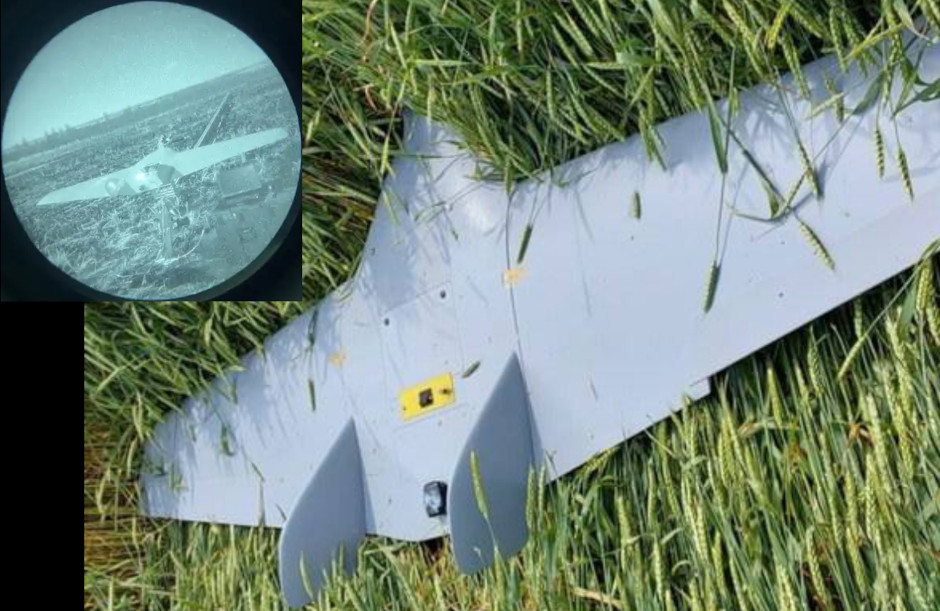
Example from May 2023
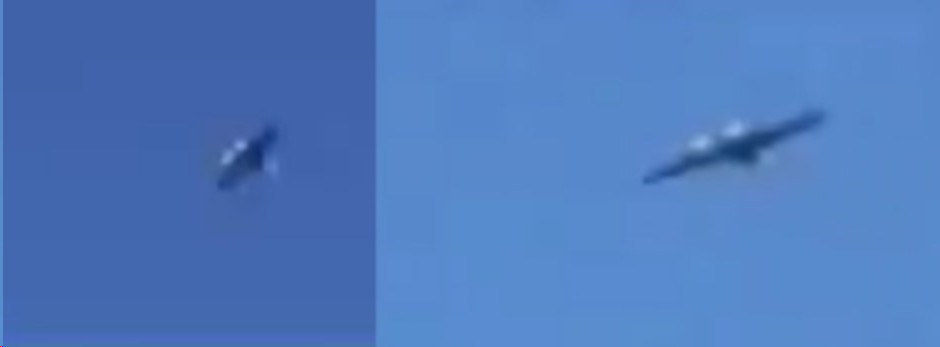
Example observed over Russia March 12 2024.
A22 Foxbat
On April 2 2024 a large drone was filmed diving into a building associated with a factory in Yelabuga, Tatarstan. The factory, which reportedly manufacturers Shahed type drones, is 1,300km (807 miles) from the Ukraine-Russia border. The drone appears to be a weaponized light aircraft. Numerous sources identified the base aircraft as a Ukrainian made Aeroprakt A-22 Foxbat ultralight.
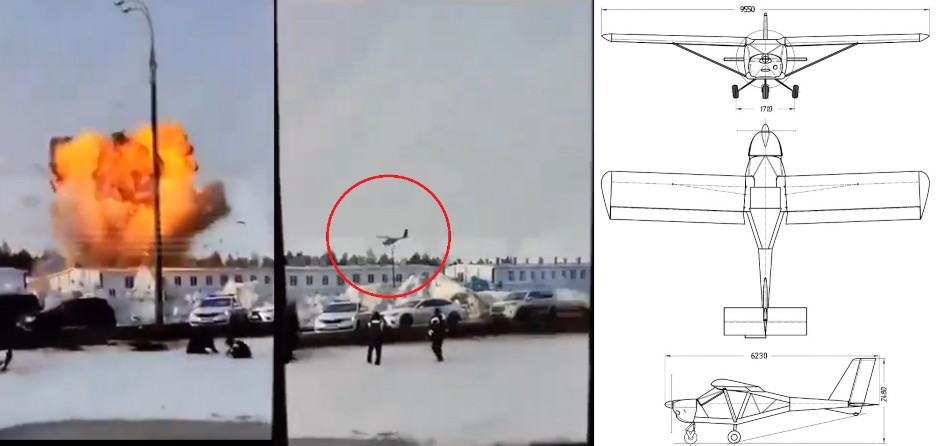
The final approach was caught on camera. It appears to be a drone using an A22 Foxbat airframe.
Sky Ranger Nynja
On April 26 2024 images of a light aircraft crashed in a field were shared on Russian social media. The plane, a variant of the Ukrainian produced Sky Ranger Nynja, has been converted into an uncrewed aircraft.
A single OFAB-100-120 aerial bomb is strapped to a rail under the fuselage. A long-serving Soviet design, it weighs 100kg and contains 42kg of explosives. At first sight it might appear that the bomb would be dropped on the target, but it appears to be intended as a one-way system. Another unusual feature for an OWA-UAV is that there is a camera ball under the fuselage. This suggests a high-bandwidth two-way communications capability, which would possibly allow greater accuracy, especially in a GPS denied environment.
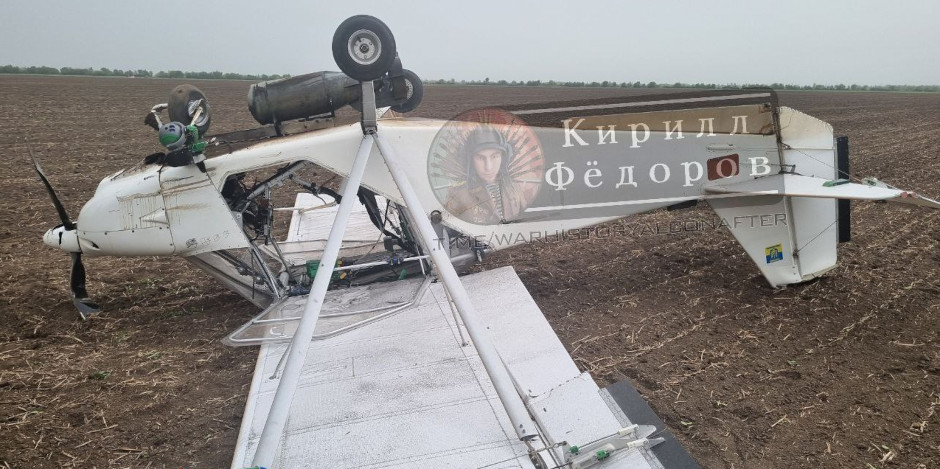
FP-1
In April 2024 the wreck of a twin-boom design was filmed in the Oryol Region of Russia. Photographs of another followed a few days later. The design matches one revealed in a Ukrainian media interview in October 2023. Russian reports suggest a blast-fragmentation 40kg warhead consisting of 25 kg of tetryl high explosive surrounded by 15 kg of steel balls. The model's name was later identified by Russian sources as FP-1.
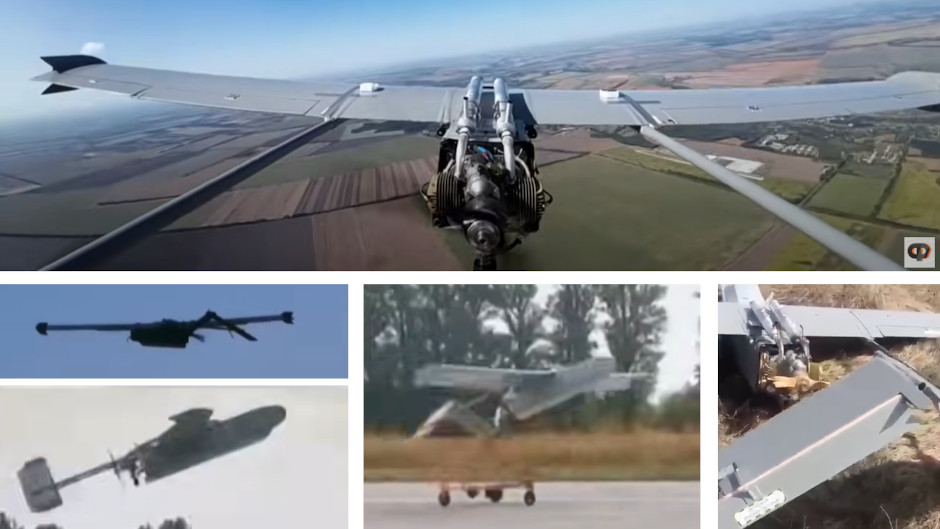
Screen shots from a media report on the type, and also a crashed example in Russia.
Dart 250
 The Dart 350 is produced by British firm Modini. It is a small jet based design with canards and a distinctive triangular tail. It is powered by the same company's GT-500 turbine with around 50 kg thrust. A specialist anti-radar version is the Dart 250EW. Wingspan is 2.9 meters, payload 25 kg, range over 250 km, fuel around 33kg, speed reported as 432 km per hour (120 meters per second).
The Dart 350 is produced by British firm Modini. It is a small jet based design with canards and a distinctive triangular tail. It is powered by the same company's GT-500 turbine with around 50 kg thrust. A specialist anti-radar version is the Dart 250EW. Wingspan is 2.9 meters, payload 25 kg, range over 250 km, fuel around 33kg, speed reported as 432 km per hour (120 meters per second).
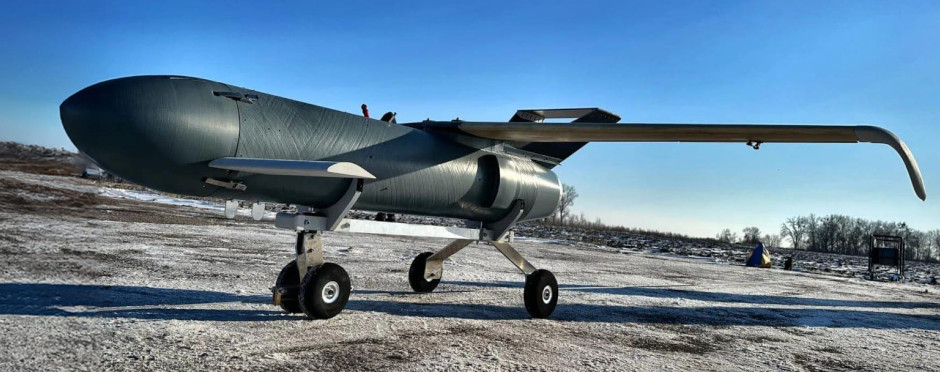
The Dart 350 is in serial production.
Unnamed types
Several drones have been reported in Russia, or shown to the public, but not named.
?1
On December 9 2023 at least two of this type of drone were found crashed in Russia, and another in March 2024. These have a very simple layout with simple tubular fuselage. The tail surfaces, both vertical and horizontal, are the same, showing that it is designed for cheap manufacturing and ease of assembly. The aft fuselage is made from a hollow pipe and plastic bottles are used as the fuel tanks. A warhead was strapped under the nose just behind the piston engine. This is one of a new breed of Ukrainian OWA-UAV optimized for low cost manufacturer.
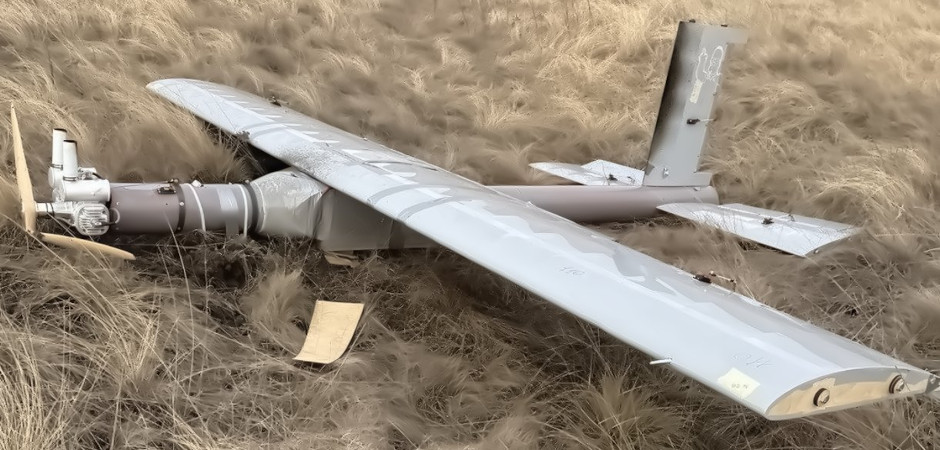
?2
On Feb 7, 2024, a crashed example of the jet powered drone was shared on Russian social media. It is evidently a type of one-way attack drone (OWA-UAV). See main article.
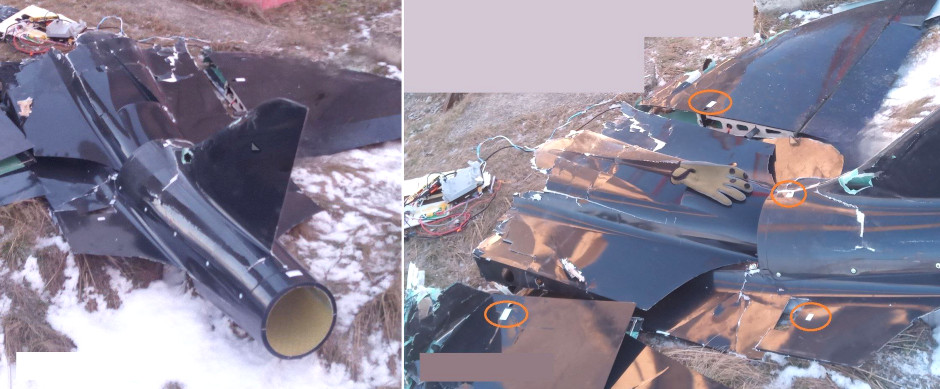
Photographs shared online of the wreck. Note that the lower fuselage is upside down, the intake is on the bottom.
?3
This type of drone was used in an attack on Russian air defences at Yevpatoriya, Crimea September 2023. Since then they have been used multiple times inside Russia.

A prototype was shown alongside Chaklun drones in November 2022. Note the different engine, winglets, and presence of landing gear.
The drone is equipped with a single Chinese-made 12 hp DLE 120 piston engine in a pusher configuration. The engine is mounted high with a distinctive fairing in front of it. The wings include extended wing roots and small end plates. The tail is a twin-boom arrangement with tapered vertical stabilizers with a horizontal tail on top.

?4
A large drone around with a 'loitering munition' form. It has a 4 meters wingspan and is 2.7 meters long, and is equipped with a 14 kg warhead. Further details unclear.
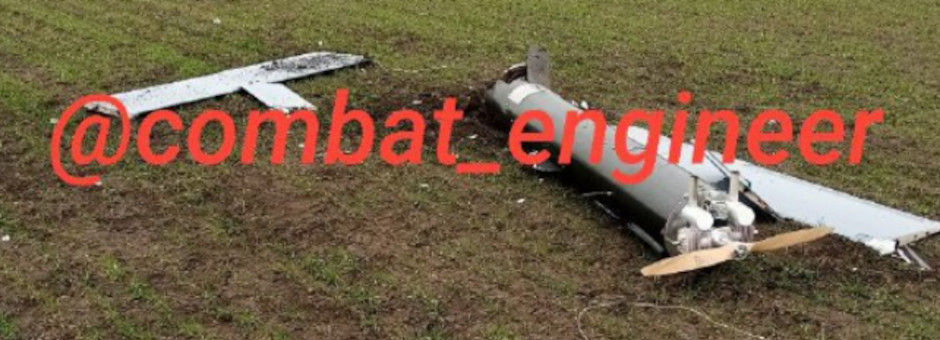
?5
On June 27 2024 images of a crashed jet powered flying wing drone was shared on Russian social media. The design is reportedly powered by a commercially available single SW140B turbine.

?6
On Jan 29, 2024 a Ukrainian drone fell at an oil refinery in Yaroslavl, Russia, about 900 km from Ukraine. There are few details but we can deduce its overall layout. It has a box-like fuselage and tractor (front-mounted) propeller, a V- tail and anhedral wings (drooping down to the tips). Russian sources estimate the length as 1.5 meters, wingspan of 3 meters and warhead as 10 kg.
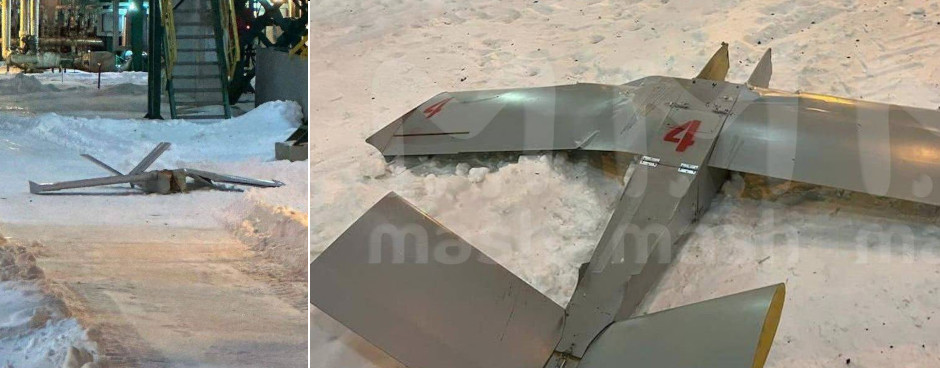
Note that it appears upside down
?7
A twin-boom design observed crashed in Russia several times over the summer of 2024. This drone is a strong visual match to a design from Aevex Aerospace in the United States. Howqever the rekationship has not been confirmed. The layout similar to FP-1 but distinct from it. Possibly carbon fiber construction.
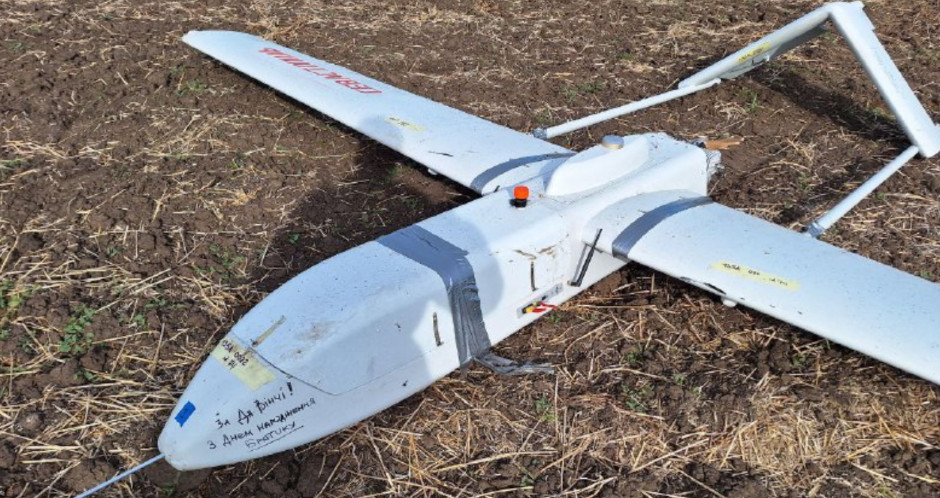
A crashed example in Russia (above), and a graphic from Aevex Aerospace's website (below).
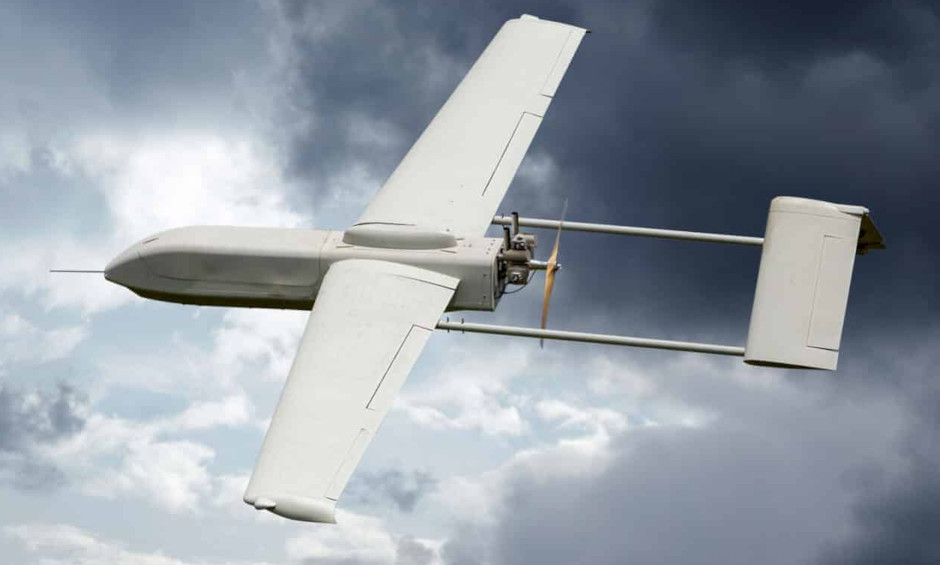
?8
Ukrainian flying wing UAV generally similar layout to Iranian (and Russian operated) Shahed design. Can be identified by swept endplates.
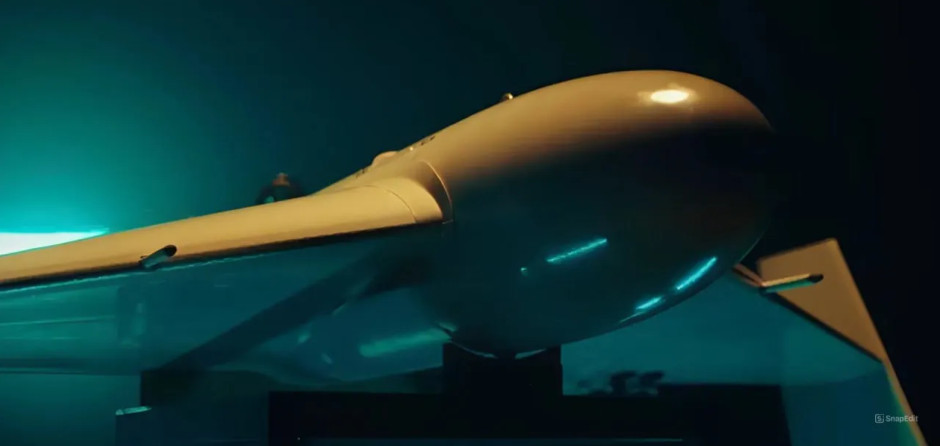
?9
Ukrainian delta wing UAV broadly similar to Shahed but with small canards forward, first reported on July 4 2025 during attacks on targets in Russia. The drone has been seen diving steeply to strike the target.

?10 Balloon Bomber
Both Ukraine and Russia have used balloons. In general, the weather systems are likely to favor Ukraine in this area however, allowing very high-altitude attacks. These can be extremely difficult, and expensive, to intercept. The main challenge is navigation however since the balloons are largely at the mercy of the wind.
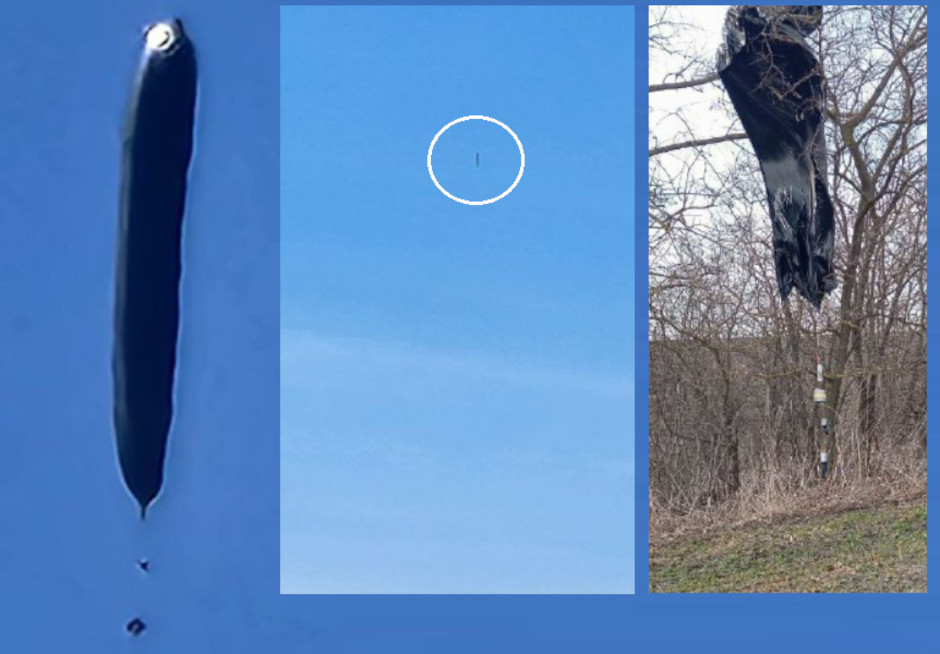
Observed Ukrainian types are sausage shaped, floating vertically, with a control unit, GPS tracker and bomb suspended below. A water bottle is also attached to the string. While these appear crude, they are likely to be increasingly sophisticated.
Also of note
Gorgon
Ukrainian drone manufacturer Miltech Group lists the 'Gorgon' OWA-UAV. Range and payload, and operational status is unclear.
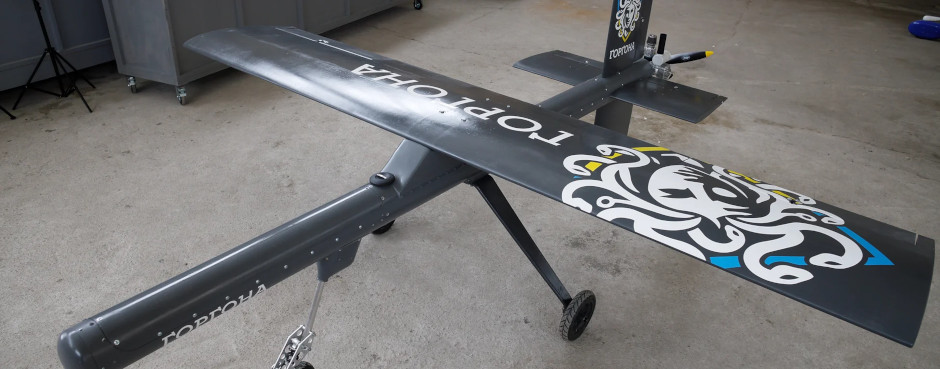
E-300 Enterprise & D-80 Discovery
Ukrainian manufacturer AeroDrone supplies the E-300 Enterprise & D-80 Discovery drones. Currently neither has been confirmed being used in strategic strikes. The E-300 resembles a light aircraft and is based on the Aeros Skyranger. The ungainly yet functional D-80 Discovery was originally intended for agricultural work.

E-300 Enterprise (left) & D-80 Discovery (right)
Related articles (Full index of popular Covert Shores articles)





 World survey of Underwater Attack Drones (OWA-AUVs)
World survey of Underwater Attack Drones (OWA-AUVs)

 Ukraine's Maritime Drones (USVs)
Ukraine's Maritime Drones (USVs)




 World survey of Navy Marine Mammal Prorams
World survey of Navy Marine Mammal Prorams

 Ukraine's longer-ranged missiles
Ukraine's longer-ranged missiles
